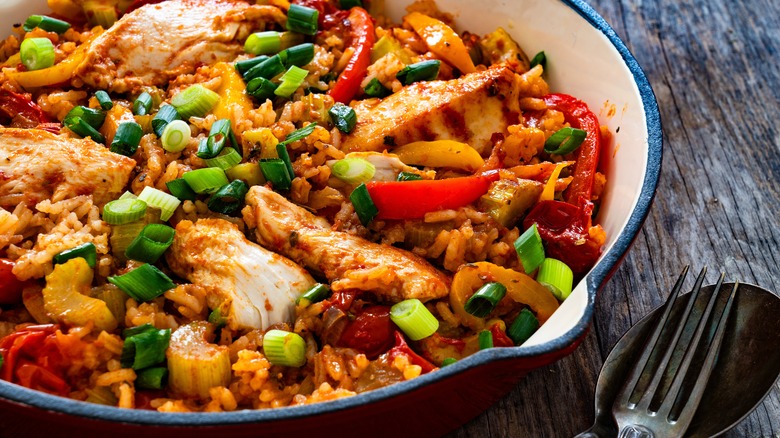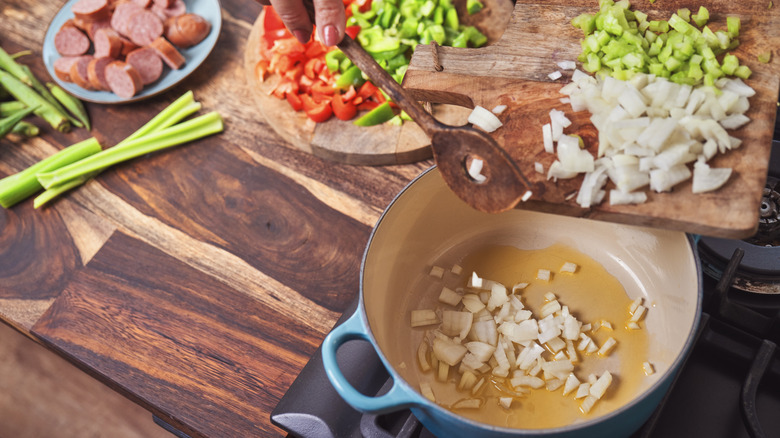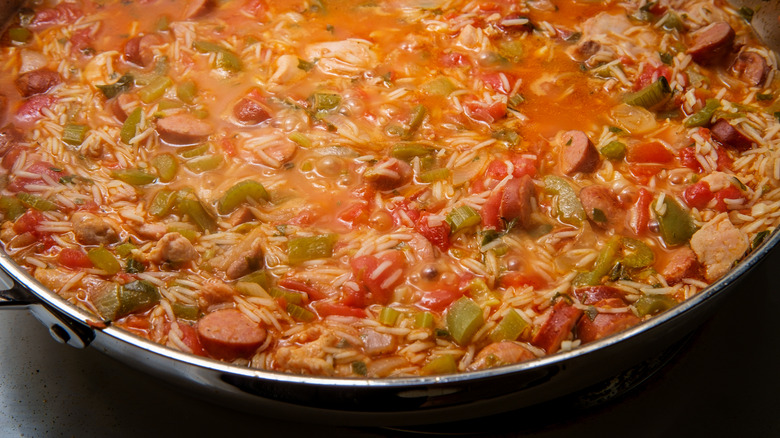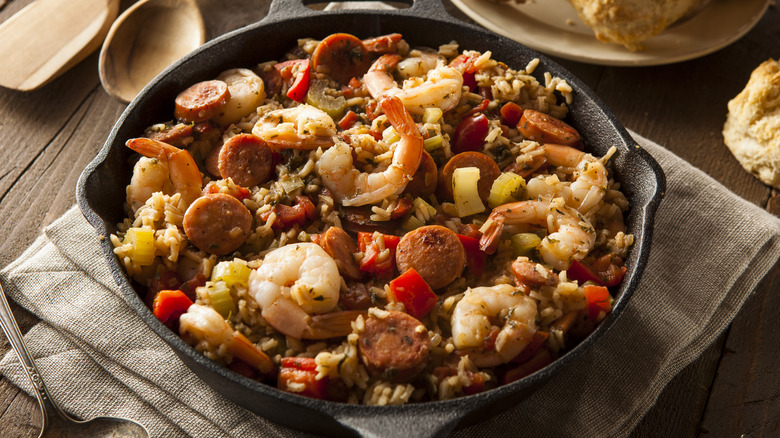What's The Difference Between Creole And Cajun Jambalaya
Louisiana is a food lover's paradise, serving up a spicy, soulful blend of Creole and Cajun foods. It's no surprise that many of the area's trademark dishes have versions reflecting both of these culinary influences. The mixed rice dish jambalaya, for instance, has Creole and Cajun variants that are both beloved in Louisiana. Both versions begin with similar foundations but differ in a few key ways that show off the strengths of each style of cooking.
Creole jambalaya, a product of New Orleans, typically features tomatoes and refined ingredients like seafood and chicken. It's a nod to the city's French and Spanish heritage and boasts an intricate flavor profile. Cajun jambalaya, on the other hand, hails from rural Louisiana, is tomato-free, and might utilize a dark roux for flavor. It leans heavily on smoked meats and is more rustic — a hearty reflection of the region's working-class roots. These culinary traditions reflect the diverse history of the region.
Creole and Cajun jambalaya start out the same
Jambalaya is a one-pot wonder that draws on local ingredients mixed with traditional recipes and techniques from Europe and Africa. The dish is Louisiana's twist on Spanish paella or African jollof rice. Long-grain rice is the canvas for all jambalaya variations, ensuring a fluffy, not sticky result. The essential trio of onion, bell pepper, and celery — affectionately known as the Holy Trinity — adds a flavor base that is uniquely Louisiana.
The chosen meats are browned to perfection in a large skillet, then the vegetables are added along with a spice blend including cayenne, paprika, thyme, and garlic. When the vegetables are soft and aromatic, the rice gets a quick toss in the pan. Finally, a rich broth is poured over the top to ensure every grain is infused with flavor as it cooks. Like paella, the rice mixture is cooked on the stovetop with minimal stirring to prevent the rice from becoming gummy or breaking. When the rice is tender, it's time to dig in.
What is Creole jambalaya
The term Creole originally referred to people born in the New World; the descendants of travelers who brought their cooking traditions with them. Creole cuisine subsequently emerged as a unique fusion of French, Spanish, African, and Native American culinary arts. The common ingredients reflect those diverse cultures and feature an emphasis on ripe tomatoes, fresh herbs, and rich sauces.
The key distinguishing trait of Creole jambalaya when compared to the Cajun variant is its red color, which comes from the use of tomatoes. This hallmark ingredient imparts a slight sweetness and enhances the overall complexity of the dish. Tomatoes reflect the Spanish and African influences that Creole cooks brought to their kitchens. Certain Creole spices, like oregano, bay leaf, and basil might also make an appearance in jambalaya but with less of a focus on fiery hot spices. The signature meats used in Creole jambalaya are most frequently local seafood, chicken, or a combination of both.
What is Cajun jambalaya
Cajun cooking originated in the region of Canada formerly known as Acadia amongst French settlers who were expelled by the British in the 18th century. They resettled in Louisiana, often in the bayous and swamps. Over time, their culinary traditions blended with local Native American and African influences, giving birth to what we now know as Cajun cuisine. It's characterized by bold, spicy flavors, the use of locally available ingredients, and a deep connection to the land and waterways.
One of the primary differences in Cajun jambalaya as opposed to the Creole variant is the absence of tomatoes. Instead, it relies on a dark roux (which is a cooked mixture of flour and fat) to achieve a deep, smoky flavor. Country meats like andouille sausage, tasso ham, or game meats take center stage. The Cajun spice profile leans towards bold and earthy flavors, often featuring the likes of cayenne pepper and black pepper. Cajun jambalaya's roots in the countryside and its reliance on smoked meats make it a quintessentially rustic creation.



